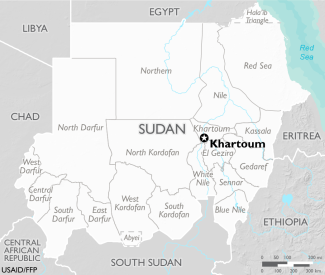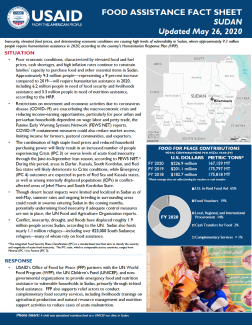May 26, 2020
Insecurity, elevated food prices, and deteriorating economic conditions are causing high levels of vulnerability in Sudan, where approximately 9.3 million people require humanitarian assistance in 2020, according to the country’s Humanitarian Response Plan (HRP).
Situation
- Poor economic conditions, characterized by elevated food and fuel prices, cash shortages, and high inflation rates continue to constrain families’ capacity to purchase food and other essential items in Sudan. Approximately 9.3 million people—representing a 9 percent increase compared to 2019—will require humanitarian assistance in 2020, including 6.2 million people in need of food security and livelihoods assistance and 3.3 million people in need of nutrition assistance, according to the HRP.
- Restrictions on movement and economic activities due to coronavirus disease (COVID-19) are exacerbating the macroeconomic crisis and reducing income-earning opportunities, particularly for poor urban and peri-urban households dependent on wage labor and petty trade, the Famine Early Warning Systems Network (FEWS NET) reports. COVID-19 containment measures could also reduce market access, limiting income for farmers, pastoral communities, and exporters.
- The combination of high staple food prices and reduced household purchasing power will likely result in an increased number of people experiencing Crisis (IPC 3) or worse levels of acute food insecurity through the June-to-September lean season, according to FEWS NET.* During this period, areas in Darfur, Kassala, South Kordofan, and Red Sea states will likely deteriorate to Crisis conditions, while Emergency (IPC 4) outcomes are expected in parts of Red Sea and Kassala states, as well as among internally displaced populations (IDPs) in conflict-affected areas of Jebel Marra and South Kordofan State.
- Though desert locust impacts were limited and localized in Sudan as of mid-May, summer rains and ongoing breeding in surrounding areas could result in swarms entering Sudan in the coming months, potentially undermining food insecurity if adequate control measures are not in place, the UN Food and Agriculture Organization reports.
- Conflict, insecurity, drought, and floods have displaced roughly 1.9 million people across Sudan, according to the UN. Sudan also hosts nearly 1.1 million refugees—including over 823,000 South Sudanese refugees—many of whom rely on food assistance.
* The Integrated Phase Classification (IPC) is a standardized tool that aims to classify the severity and magnitude of food insecurity. The IPC scale, which is comparable across countries, ranges from Minimal (IPC 1) to Famine (IPC 5).
Response
- USAID’s Office of Food for Peace (FFP) partners with the UN World Food Program (WFP), the UN Children’s Fund (UNICEF), and non-governmental organizations to provide emergency food and nutrition assistance to vulnerable households in Sudan, primarily through in-kind food assistance. FFP also supports relief actors to conduct complementary food security services, including livelihoods trainings on agricultural production and natural resource management and nutrition support activities to reduce cases of acute malnutrition.
Food for Peace Contributions
Total Contributions:
| U.S. Dollars | Metric Tons | |
|---|---|---|
| Fiscal Year 2020 | $226.9 million | 167,159 MT |
| Fiscal Year 2019 | $201.1 million | 175,797 MT |
| Fiscal Year 2018 | $182.7 million | 175,818 MT |
* Metric tonnage does not reflect funding for vouchers or cash transfers.
Related Resources


